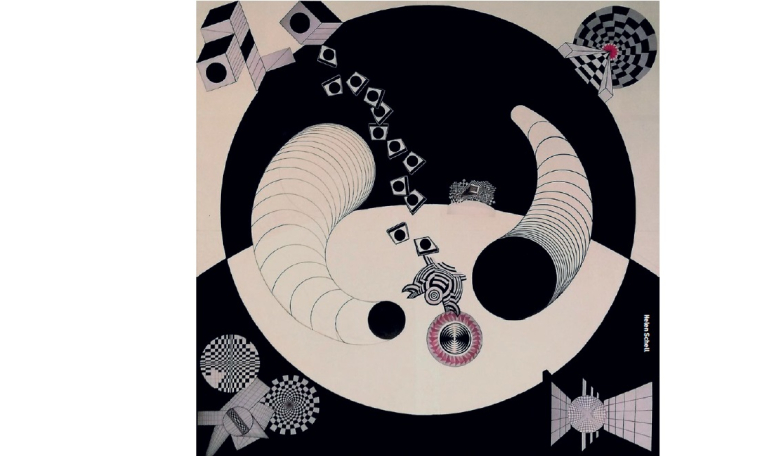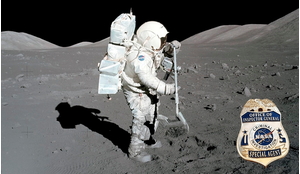Recent twenty-first century space endeavours have resulted in the need for extensive research into altered gravity’s impact on visual physiology and perception. Artist and space educator Helen Schell was inspired to consider how artists inaugurate innovation using creative thinking to enhance this research. Her pioneering and visionary project, The Human Spaceship, unites art and science, through the production, publication and public display of bold paintings of scale.
My project the ‘Human Spaceship - Off Balance’, and its associated investigations (including Moon-shot: Woman on the Moon, Upon the Moon, A Slice of the Moon and Escape Velocity), explores our understanding of visual perception issues in altered gravity and resolutions using creative thinking in terms of human space travel and settlement plans.
The project also examines the multisensory connections with related brain activities and physical changes including balance, spatial orientation, and cognitive functions. With the dramatic lighting, lack of colour, variable gravity and lack of atmosphere, this could create optical illusions within our ‘Earth brains’, producing the perception of something in a way that causes the misinterpretation of its actual appearance.
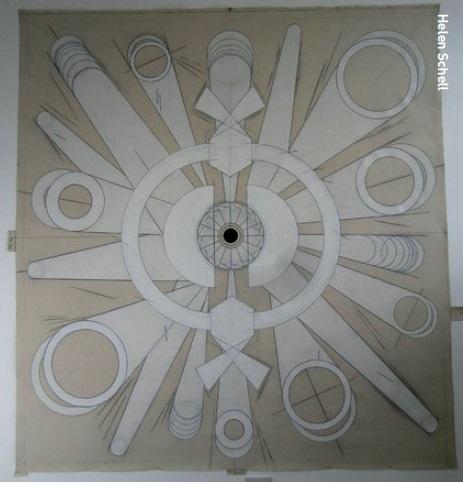 Double Vision Acrylic paint and graphite pencil on canvas. Size 2.75m high x 2.5m wide. 2022 (The Human Spaceship – Upon the Moon). Depicting light and white, with concepts of double vision and phosphenes (brain-created colours).
Double Vision Acrylic paint and graphite pencil on canvas. Size 2.75m high x 2.5m wide. 2022 (The Human Spaceship – Upon the Moon). Depicting light and white, with concepts of double vision and phosphenes (brain-created colours).
Optical illusion
It can be evidenced that many artists and art movements have advanced visual thinking and perception, changing the way we live and behave
Compared with Earth, space is like a giant optical illusion, causing visual aberrations and physical alterations. Helen Schell’s extensive investigations for The Human Spaceship art project have added to the bank of knowledge and innovation within the field of perception in space sciences and art practice. This is demonstrated through artworks depicting colour, line and form, using geometric optical illusions to express visual conditions on the International Space Station (ISS) and on the Moon and Mars with investigations examining many visual and psychological considerations. These optical illusions present a persistent destabilising vision for the spectator through images which depict spatial disorientation, inducing sensations of being ‘off balance’.
New questions are being asked and answered in the context of a lunar base camp and planned missions to Mars. With the emergence of new space industries and space agencies, there are initiatives to build commercial space stations for science and tourism, so these issues must be addressed both practically and aesthetically.
By introducing new collaborative art and science research, which looks at space living designs, culture and materials in a holistic manner, it can be seen that ‘off world’ living must consider geometric proportion, colour, creative thinking and lighting. These should include the mathematics of patterns and proportions of nature, sometimes referred to as the universal language of ‘sacred geometry’, existing, historically throughout world cultures.
 Rocket Engines - Acrylic paint and graphite pencil on canvas. Size 1.81m high x 10m long (The Human Spaceship – Upon the Moon). Depicting geometric proportion, colour and line, examining visual perturbations, aberrations and sensations of being ‘off-balance’.
Rocket Engines - Acrylic paint and graphite pencil on canvas. Size 1.81m high x 10m long (The Human Spaceship – Upon the Moon). Depicting geometric proportion, colour and line, examining visual perturbations, aberrations and sensations of being ‘off-balance’.
Art, Artists and Architectural Methods
The Human Spaceship study makes the case for the sciences to extend their processes to include greater connections with artists. Key influences for artists are: examining how we see, what we understand visually and how to interpret these as tangible ideas. Referencing the sophisticated visual comprehension and multidisciplinary artworks created by artists (both historically and contemporary), they question societal behaviours, thus leading to visionary concepts and modernist interpretations (what has never been before). It can be evidenced that many artists and art movements have advanced visual thinking and perception, changing the way we live and behave. In a wider context, many space scientists confirm that they were led into their professions by the cultural experiences (often science fiction) of their youth, including literature, films, television, music and the visual arts.
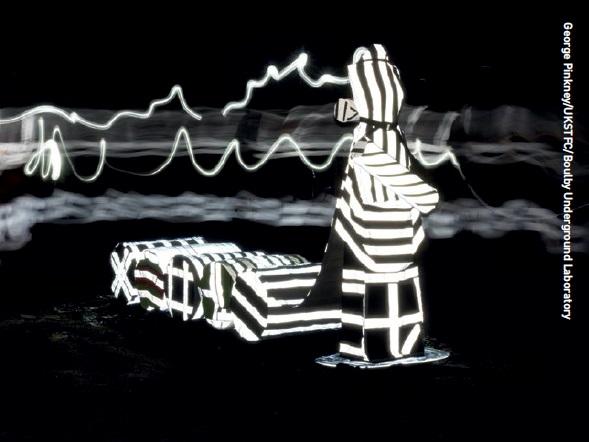 Midnight on the Moon Dress - Investigations in Boulby Mine muted light conditions relating to spacesuit technology, darkness and muted vision. Size 2.0m high x 4.0m long x 1.0m wide
Midnight on the Moon Dress - Investigations in Boulby Mine muted light conditions relating to spacesuit technology, darkness and muted vision. Size 2.0m high x 4.0m long x 1.0m wide
In the 21st century, this extends to space architecture and the requirement for inspiring and practical habitat designs which need to endure in ‘off-world’ landscapes and encompass natural resources. Along with regolith 3D printing methods, growing habitats from plants is also being considered, but there is still much research required to overcome the challenges of living in the hostile environment of the Moon, Mars and space.
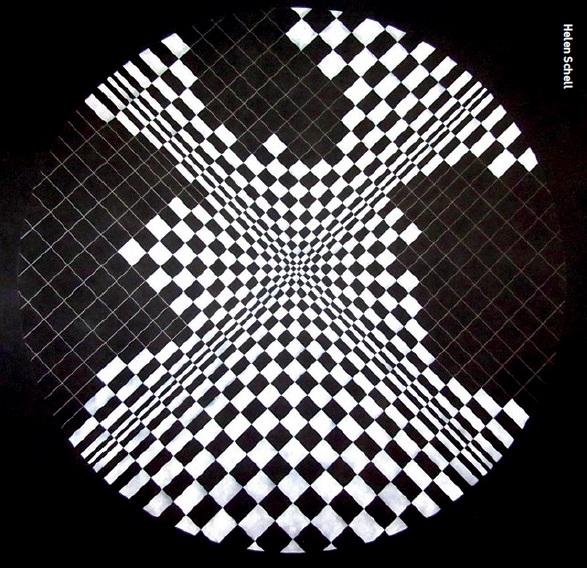 Moon Night - Acrylic paint and graphite pencil on canvas. Size 1.77m x 1.77m. 2020 (The Human Spaceship - Off Balance). Depicting extreme darkness and distance perception in deceptive spatial landscapes.
Moon Night - Acrylic paint and graphite pencil on canvas. Size 1.77m x 1.77m. 2020 (The Human Spaceship - Off Balance). Depicting extreme darkness and distance perception in deceptive spatial landscapes.
Throughout the development of human architecture, natural habitats, human built structures and new technology designs have been inspired by nature, drawing on the mathematical proportions of Earth’s geology, flora and fauna. This is strongly linked to our understanding of planets and stars through the development of celestial geometry, informing the creation of our greatest historical monuments through a universal language across all cultures. Further analogue information can be gathered from challenging environments on Earth, from submariners, miners and humans who live in the extreme conditions of Antarctica, but these should not be mistaken for actual space conditions.
Vision factors in altered gravity
Compared with Earth, space is like a giant optical illusion, causing visual aberrations and physical alterations
Space is like a giant optical illusion. There is no ‘right way up’, no aerial perspective, the horizon line rapidly changes, and there are very different lighting conditions. Our brain and eyes work together to see our three-dimensional world, informing us about depth, tone, lighting, colour and position to interpret what we see. But this can be confused when they receive information in a conflicting manner, possibly manipulated by nature or technology. On Mars, humans would experience a gloomy red/orange landscape with limited sunlight and heat, like a winter’s day on Earth. Astronauts on the ISS can develop spaceflight associated neuro-ocular syndrome (SANS), becoming more far-sighted and having trouble seeing things close up. A long journey to Mars might induce short-sightedness due to a lack of distance stimulation and prolonged use of digital technology. On the Moon there is a muted colour range (achromatic), with two weeks of freezing darkness during a lunar night and two weeks of dazzling hot sunlight during a lunar day. There are also polar regions of constant darkness and light, with a retro-reflective regolith.
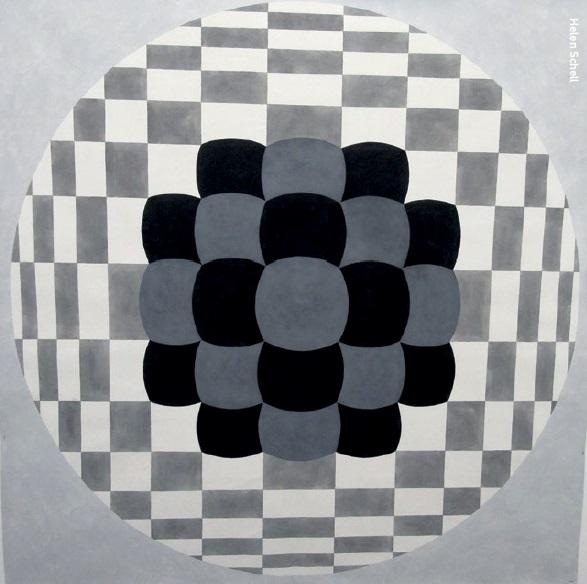 Moon Day - Acrylic paint and graphite pencil on canvas. Size 1.77m x 1.77m. 2020 (The Human Spaceship - Off Balance). Depicting whites and greys, and distance perception in deceptive spatial landscapes.
Moon Day - Acrylic paint and graphite pencil on canvas. Size 1.77m x 1.77m. 2020 (The Human Spaceship - Off Balance). Depicting whites and greys, and distance perception in deceptive spatial landscapes.
We can expect three main types of optical illusions to manifest themselves on the Moon, Mars and in spaceships:
- Literal illusions such as pareidolia (detecting an object, pattern, or meaning where there is none), rapid light/dark visual adjustments and distorted distance perception.
- Physiological illusions, such as multiple patterns, lighting conditions, phosphenes (double vison and after-images), colour misconceptions, particularly caused by black and white interactions (including moirés).
- Cognitive illusions, meaning visual perception doesn’t connect with the brain’s recognition of what it sees. These could include hallucinations, apparitions and mirages possibly caused by medical, technical or landscape influences.
Specific Visual Factors
There is still much research required to overcome the challenges of living in the hostile space environment on the Moon, Mars and space
- Nyctophobia is an innate fear of the dark, possibly caused by Moon blackness (long nights, vast shadows, deep craters and black skies). This can cause breathlessness, sweating, nausea, shaking, heart palpitations and unclear communication. This enhances feelings of claustrophobia, detachment and isolation and insomnia.
- Pareidolia & moiré effects can be caused by the bold black, white and grey lunar landscape, producing dramatic light/shadow contrast and misleading focal points, which could confuse astronauts, as visual perception imposes different interpretations on the surroundings and objects. This could induce visual misunderstanding, such as a lunar mirage, where a crater hole might appear as a surface plane or a rock feature as a shadow or negative surface. In the strong lunar light, craters can appear as concave or convex illusions.
- Visual perturbations (disturbance of motion and balance) cause sudden changes in the visual field, induced by altered gravity, unusual landscapes and dramatic lighting conditions.
- Hypercapnia is temporary blindness caused by a lack of blood flow to the eye, possibly inducing phosphenes. This can be caused by microgravity conditions or breathing in too much carbon dioxide.
- Phosphenes can cause colours and shapes (visual worms and geometric patterns) in the visual system of your brain and induce double vision and after images in certain lighting circumstances, as the brain continues to seek visual activity and stimulation.
- Far-sightedness can affect astronauts after long periods on the ISS, caused by SANS, where the optic nerve is flattened and the eye becomes egg-shaped, caused by the movement of spinal fluid, changing the focal point.
- Short-sightedness (myopia) could affect astronauts living in confined spaceships/habitats for long periods and those with extended use of digital technology, (distant objects appear out of focus with muted colours). This can be linked to the experience of submariners, who are more likely to suffer from myopia, esophoria (eye misalignment) and accommodative power issues (the ability of the lens to adjust its focal length).
- Spacesuit helmets use three layers of protective plastic, which is not only light limiting, but can be coated in static dust. New elliptical shaped helmets offer a better view of the landscape and astronaut’s feet, enabling better stability.
- Muted lighting caused by spacecraft windows and spacesuit visors restricts an astronaut’s eyesight and visual panorama, and these conditions may suppress melatonin, weakening alertness and disturbing sleep patterns. The red/orange Martian landscape (at only 44 percent of Earth’s light) would mute colours and textures, causing blurred landscapes and mistaken distance perception, in dusk-like conditions with atmospheric dust.
- Artificial exterior lighting is likely to be spotlights or beams, which cause an array of light, creating a dazzle factor. This effect, causes blind-spots around the lights (and after images) as they draw your focus, also blocking out dimmer background objects.
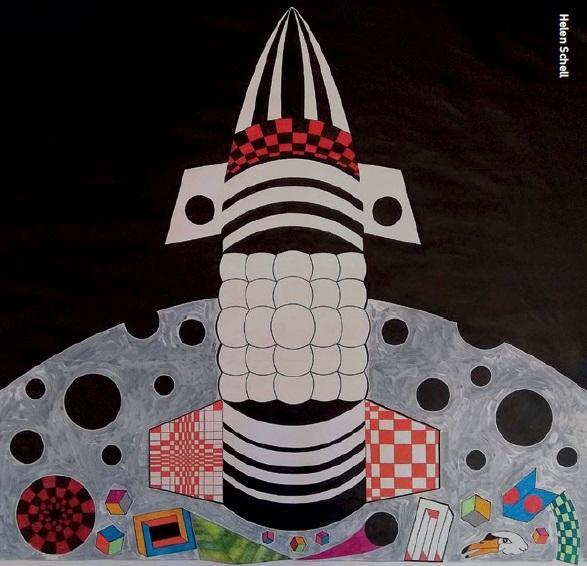 The Human Spaceship – Upon the Moon (NASA Human Research Program Poster 24). Acrylic paint, ink and collage on paper (detail). Size 1.1m high x 82cm wide. 2024. Depicting multiple visual lunar phenomena.
The Human Spaceship – Upon the Moon (NASA Human Research Program Poster 24). Acrylic paint, ink and collage on paper (detail). Size 1.1m high x 82cm wide. 2024. Depicting multiple visual lunar phenomena.
Geometry and patternmaking
Geometric symbols and proportions can enhance our comprehension of our surroundings and objects and can also support emotional therapyHelen
Geometric symbols and proportions can enhance our comprehension of our surroundings and objects and can also support emotional therapy, making this a genuine tool for improvement. Geometric knowledge is fundamental in navigation, which humans learn early on, developing abilities to understand length, angle, distance, direction and balance and we constantly improve our brains using a geometric language of symbols and patterns. Nature strives for symmetry through gravitational influences, producing mathematical repetitions within growth patterns. As geometry and colour recognition are inherent in human learning processes and well-being, astronauts will need nature’s geometric proportions and colours as countermeasures and stimuli for the five human senses to flourish and for communication. Embedded visual symbols and patterns can be achieved through art, design, architecture and creative thinking.
Given the potentially extensive confinement and isolation of long duration spaceflight and space habitation, interior design should include these natural patterns and proportions. Specifically designed geometry, colour and proportions can mitigate the lack of stimuli in the small physical structures. These mathematical patterns occur naturally and have been used for cultural structures and rituals throughout Earth’s societies, creating proven harmony and wellbeing within our brains. Spaceship designers (with artists) should include these factors to induce psychological and physical harmony and also to induce regular sleep patterns.
The case for hybrid research
There is a need to invite specialist artists and designers into the planning process to mitigate adverse health factors and improve the success of future space endeavours concerning altered gravity’s impact on visual physiology and perception. This makes the case for hybrid research, which unites art and science.
If what humans perceive in space conditions (off-world) is not the same as the visual experience on Earth, then we must address these visual changes, especially in terms of unknown exploration, uncertainty and even innate animal fear, to find the solutions.
This leads us to address the perception of unexpected and unrecognisable landscape features, which are dramatically changed by lack of atmosphere and unusual lighting conditions, both natural and artificial. This research examines colour factors or lack of, in the lunar landscape and the Martian landscape and demonstrates that the eye and brain can be confused and misled by ‘off-world’ landscapes, inducing visual deceptions, mirages, apparitions and sensory hallucinations (across all five senses).
There is a need to invite specialist artists and designers into the planning process to mitigate adverse health factors and improve the success of future space endeavours
The research therefore concludes that what an astronaut believes they see and their failure to see what is actually there, could cause errors in judgement and activity as the human brain has a habit of completing incomplete information, trying to make sense of imagery for survival. These visual deceptions cannot be trained out of the brain, but the brain can be trained to understand the circumstances causing these optical illusions and how to respond effectively.
Humans learn and the brain can adjust at remarkable speed when a situation is understood and with repeated exposure to the experience (‘space-normal’ and ‘Earth-normal’). Visual artists are expertly trained in visual recognition and brain interpretation of unusual imagery, comprehending this in multiple ways and expressing it in practical terms. It is also believed that geometric optical illusions can improve visual acuity. These unexpected features should be investigated before humans build a settlement on the Moon (at great cost), by using proactive Earth-based collaborations to best devise mitigations to the visual challenges.
Achieving these collaborative enterprises requires mutual respect and understanding of the range of skills available so the conversations can advance quickly to practical working methods. To create new and successful societies in space, we must utilise our multiple skills on Earth.
Acknowledging that art and science are interwoven disciplines and are integral to an innovative future, human space exploration and survival must consider the creative enhancements of art, architecture, geometric proportion and colour, making the urgent case for space agencies, industries and governments to collaborate and fund artistic enterprises and their visionary concepts.
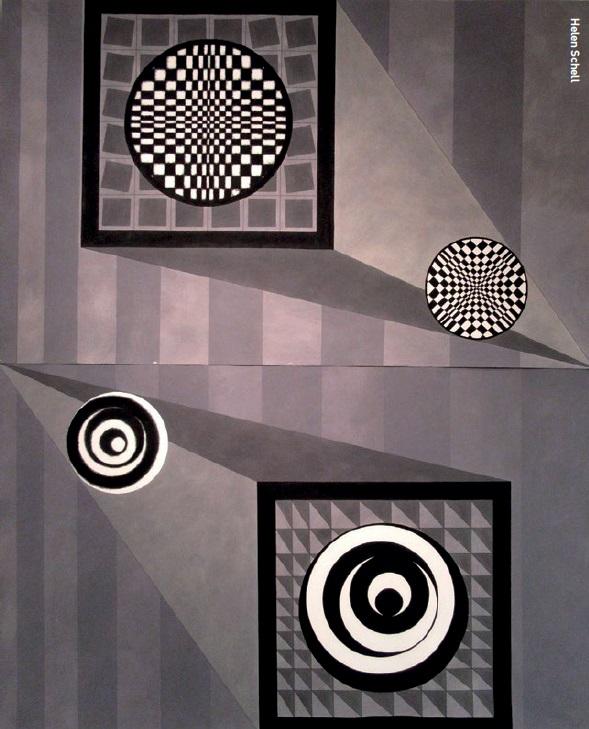 There’s No Right Way Up - Acrylic paint and graphite pencil on canvas. Size 2.18m high x 1.77m wide. 2020 (The Human Spaceship - Off Balance). Depicting long and short-sight issues within space stations and long spaceship journeys.
There’s No Right Way Up - Acrylic paint and graphite pencil on canvas. Size 2.18m high x 1.77m wide. 2020 (The Human Spaceship - Off Balance). Depicting long and short-sight issues within space stations and long spaceship journeys.
Editor’s note
An extended version of this paper published in the Journal of the British Interplanetary Society in February 2024 can be found at https://doi.org/10.59332/jbis-077-02-0056.
Helen Schell’s art exhibition ‘The Human Spaceship – Sea of the Edge’, presented as part of the UN’s World Space Week, is at Vane, Gateshead, NE8 2AP, UK, from 9-26 October 2024. Further information about this and the October 2022 exhibition, ‘Human Spaceship - Upon the Moon’, can be found at https://www.vane.org.uk.
About the author
Helen Schell is a visual artist and space science educator based in northeast England. Since 2007, she has devised and presented specialist space art projects and outreach activities, collaborating with many UK universities and art/science institutions. In 2019, she was the first artist to win the Sir Arthur Clarke Award for Space Outreach, and Moon-shot: Woman on the Moon, solo show at Ely Cathedral, won the IAU100 Moon Landing 50 Prize for Most Innovative Event (worldwide). A Moon Garden concept won the ESA Moon 3D printing Competition (Global winner). These projects and related research are presented under the auspices of The Human Spaceship.





